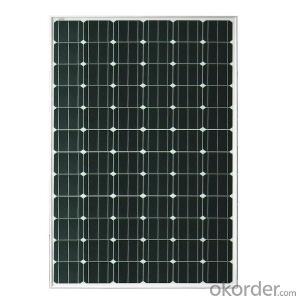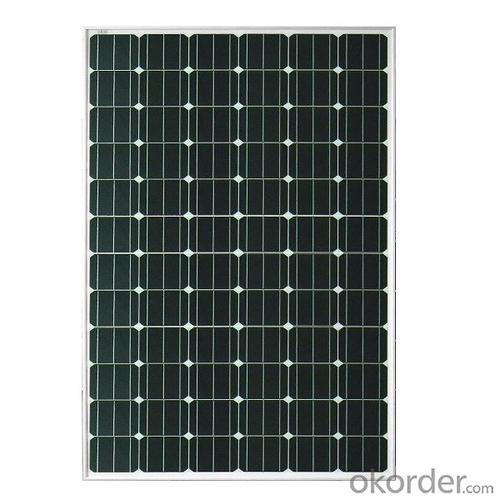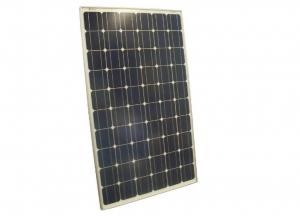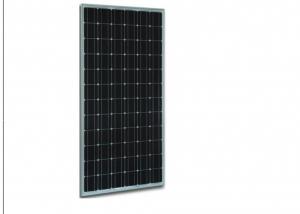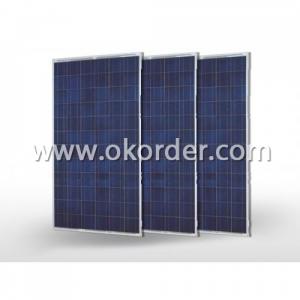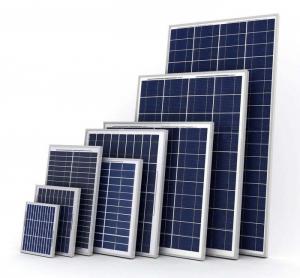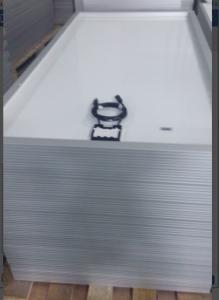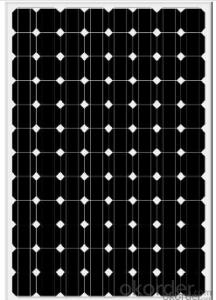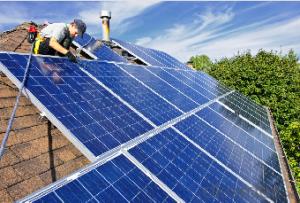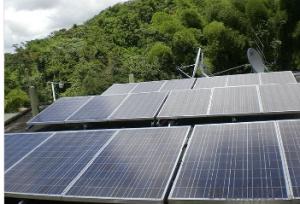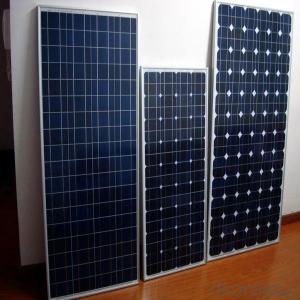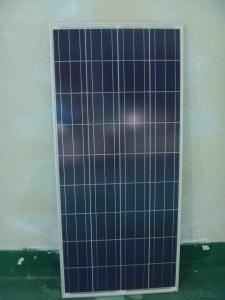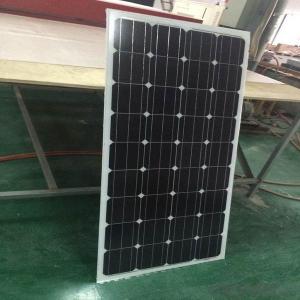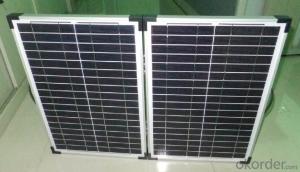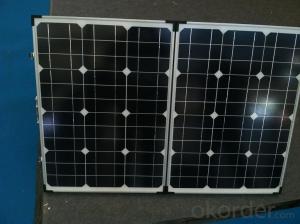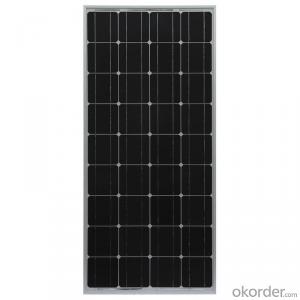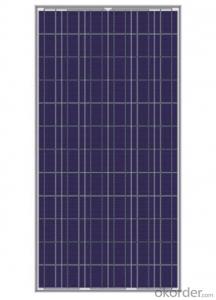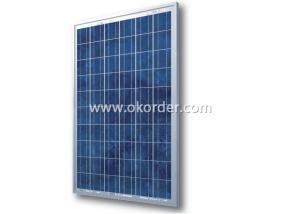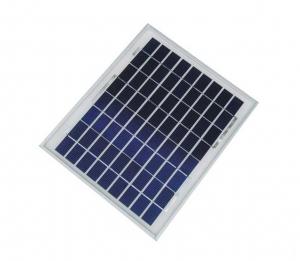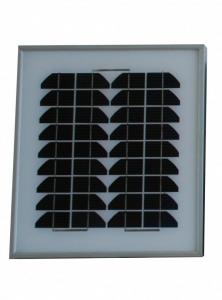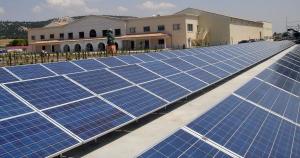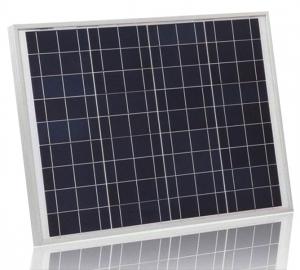115W Mono Solar Panel Made in China for Sale - Prices of Solar Panels in Zimbabwe
- Loading Port:
- Shanghai
- Payment Terms:
- TT OR LC
- Min Order Qty:
- 1000 watt
- Supply Capability:
- 1000000 watt/month
OKorder Service Pledge
OKorder Financial Service
You Might Also Like
Specification
Product Description
Product Description
Solar module/panel with high efficiency solar cells
Strong, lightweight aluminum frame design with reinforced sealing and load hold to prevent freezing and warping, and stand against high wind.
Under Standard Test Conditions(STC): Irradiance of 1000W/m2, Am1.5 and 25º C cell temperature.
Mechanical Characteristics
Dimensions: 670mm(L) x 1060mm(W) x 35mm(H)
Weight: 10.1kg
Solar Cells: Polycrystalline solar cells, 36 cells
Construction: Front: High-transmission 3.2mm tempered glass; Encapsulate: EVA; Back: TPT
Frame: Clear anodized aluminum alloy Color: Silver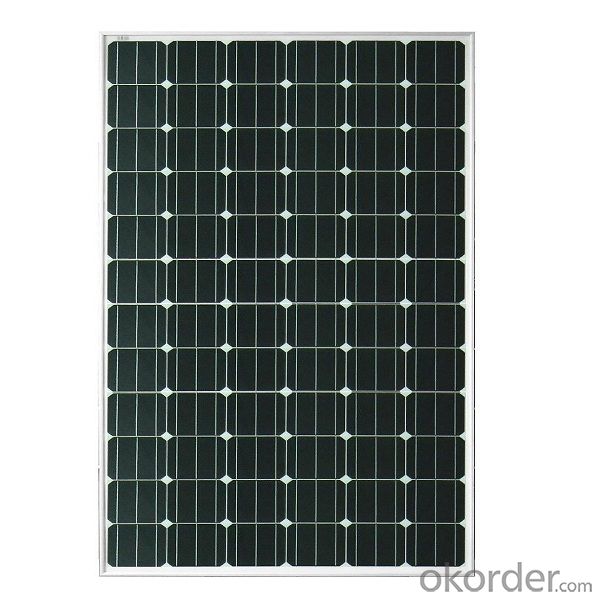
Product features:
1. The modules use high-quality imported polycrystalline or monocrystalline solar cells;
Enclosed by high-rigidity tempered glass, with excellent light transmittance and output performance;
2. Surface treated with reflection-reducing process, increasing the light absorption.
Back sealed with anti-aging EVA, resistant from moisture and corrosion.
3. The efficiency of our monocrystalline solar cell is over 17%, and polycrystalline panel is over 16%. We stipulate, the allowance of each panel's rated power has to be positive. Each panel is strictly tested before leaving the factory.
4. Our solar panel is designed with a lifetime of 25 years, and guaranteed that the power decline less than 10% within 10 years, and 20% within 20 years.
| Performance | |
| Rated Power[Pmax] | 115W |
| Power Tolerance | ± 5% |
| Nominal Voltage | 18.25V |
| Design Life | 25 years |
| Electrical Characteristics | |
| Maximum Power [Pmax] | 110W± 5% |
| Maximum Power Voltage [Vmp] | 18.25V± 3% |
| Maximum Power Current [Imp] | 6.32A± 3% |
| Short-Circuit Current [Isc] | 6.98A± 3% |
| Open-Circuit Voltage [Voc] | 21.96V± 3% |
| Current Temperature Coefficient | 0.08%/º C |
| Voltage Temperature Coefficient | - 0.32%/º C |
| Power Temperature Coefficient | -0.38%/º C |
- Q: Can solar panels be installed on vehicles?
- Yes, solar panels can be installed on vehicles. Many electric vehicles and some hybrid vehicles come equipped with solar panels to help charge their batteries. Additionally, solar panels can be installed on the roofs of various types of vehicles, such as RVs, boats, and campers, to generate electricity for powering onboard appliances and systems.
- Q: I have two solar panels that were going to be trashed at work. I want to use them to charge batteries on my RV but i noticed they put out around 20 volts in direct sunlight. So i am wondering: -isn't this way too much voltage for a 2 volt system? -do a need some sort of a regulator connected to keep them from overcharging?
- a million. confirm you get carry of the suitable form of battery that permit to can charge from the image voltaic panel. 2. confirm you utilize a gadget which I forgot the call in spite of the fact that it's going to make confident the can charge pass one way in case the sunshine pass out so won't drain the battery at the same time because it somewhat is hook up. 3. confirm you get carry of the suitable can charge from the image voltaic panel to can charge the battery. reason is easyier to swim down the river or is it basic to swim up river.
- Q: Does anybody know if there are any courses for solar panel installation, and/or what trades you need for this position?
- What you ought to recognize will depend on WHAT sort of installations you're going to be operating with. In regular, for business you wish to have fundamental mechanics and wiring. For house, you may additionally want a few carpentry, roofing, preserving structural integrity, plumbing, and so on. In side it additionally will depend on what sort of sun installations you're doing, (vigour, air warmers, water warmers, and so on.)
- Q: I was trying to figure out if I could run an electric heater off of a solar panel, but I don't understand these electric convertion factors and stuff. Would it work? (I know it'll only work in the daytime and stuff.)SOLAR PANELPeak Power 95W PTC Watts 73.0WVoc 30.7VPeak Voltage 24.4VIsc 8.6APeak Current 7.96A HEATERInput: 20 V/60 Hz ,500 W/5,200 BTU
- the panel would have to be on for 0 hours in the sun to get an hours use with the set up. try researching solar hot water heaters. they are much more efficient. a cheap one would be painting an old hot water heater black and pipe it to the new hot water heater. it will save you 80% of your electric hot water bill.
- Q: If I put a 5000 watt solar panel kit on my roof in Dublin (Ireland) - how much electricity would I realistically expect to get?An educated guess at a percentage of 5000w would do.
- Build okorder /
- Q: I recently bought a house with very old solar panels (about 25 years old) that don't appear to work properly. They are supposed to heat the hot water heater but they don't always work, and recently have staretd leaking. So, I have had them turned off and now we're just using electricity to heat the hot water. My question is, is there any tax credit money (stimulus or otherwise) available for people to (a) repair old solar panels or (b) replace them with new ones? How does the credit work?
- Congratulations okorder /
- Q: I mean when light hits the solar panel where does the energy go and what does it become? Be specific.
- Visible light from the sun is in the form of photon before hitting the solar panel. In a silicon solar panel, the photon is caught by the semiconductor material. Energy equivalent of the photon is then used to excite an electron from the semiconductor molecule. The aggregate of free flowing electrons form the current in a closed electric circuit. The efficency of conversion from sun light to electricity is not 00%. The majority of light energy hitting the solar panel is dissipated in the form of heat. As technology advances, the conversion efficiency is improving, hence reducing the cost of solar energy.
- Q: but is that per day, per hour or minute?How much watts does the average AC unit use?How much does an energy efficient lightbulb use?All in all let's hypothetically say we no longer use the electric company for our energy source, How many of these panels do you estimate it would take to supply our small home?
- The watt is a measure of instantaneous output that can also be used as an hourly measure. volt at amp for hour = watt but also a 00watt bulb requires a 00watt power source, regardless of how long it is on, the 00watts is used as an instantaneous term here. Aircon starts at about 000watts and the new energy efficient bulbs are about 7-5 watts. If you have an electric cooker, that might use 3000 watts, your computer about 500 (very variabke these days though, many are now much lower than this) Your biggest concern would be storage, solar only works when the sun shines so you need a bank of batteries to charge during the day and provide power on demand, they require proper managenemt to ensure ther are charged properly and in turn, an inverter will be required to produce the AC power your appliances will need. It all represents a huge investment with a long payback time and you would still probably need to top-up with a generator during winter, or become ahmish.
- Q: Can solar panels be installed on mountain huts or lodges?
- Yes, solar panels can be installed on mountain huts or lodges. In fact, mountainous regions with ample sunlight can be ideal locations for solar panel installations. These panels can harness the sun's energy and convert it into electricity, providing a sustainable and reliable source of power for the huts or lodges.
- Q: How many solar panels do you need on your house to power your heater in winter?
- Your house, and probably your yard wouldn't be big enough to hold them. I did this exercise once (not doing it again) for someone who wanted to replace his 6hp outboard motor with a solar powered one. The calculations ended up that he would need something like .5 acres of solar panels to get that much energy. Not happening. That said, an passive solar home, can get a significant amount of warmth from the sun directly. But it doesn't work very well at night, when it's coldest. (wonder why that is... probably a climate scientist could help us with that? -- oh, wait. They say warming doesn't have anything to do with the sun.) Edit. I didn't use theoretical stuff to come up with my numbers, I used the claims of actual off-the-shelf solar panels sold by West Marine, calculated the power, and did the math based on existing panels.
Send your message to us
115W Mono Solar Panel Made in China for Sale - Prices of Solar Panels in Zimbabwe
- Loading Port:
- Shanghai
- Payment Terms:
- TT OR LC
- Min Order Qty:
- 1000 watt
- Supply Capability:
- 1000000 watt/month
OKorder Service Pledge
OKorder Financial Service
Similar products
Hot products
Hot Searches
Related keywords
